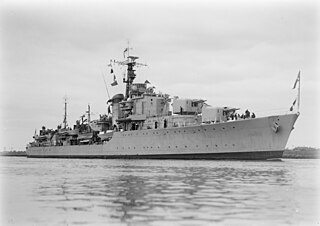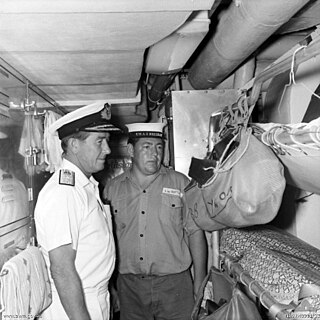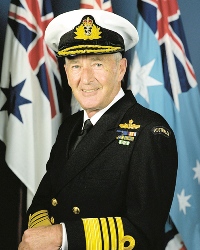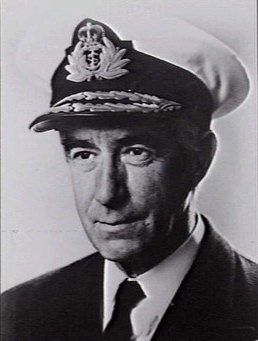Related Research Articles

The Royal Australian Navy (RAN) is the naval force of the Australian Defence Force (ADF). The professional head of the RAN is Chief of Navy (CN) Vice Admiral Mark Hammond AM, RAN. CN is also jointly responsible to the Minister of Defence (MINDEF) and the Chief of Defence Force (CDF). The Department of Defence as part of the Australian Public Service administers the ADF. In 2023, the Surface Fleet Review was introduced to outline the future of the Navy.

HMAS Sydney was an Adelaide-class guided-missile frigate of the Royal Australian Navy (RAN). The frigate was one of six modified Oliver Hazard Perry-class frigates ordered from 1977 onwards, and the third of four to be constructed in the United States of America. Laid down and launched in 1980, Sydney was named for the capital city of New South Wales, and commissioned into the RAN in 1983.

HMAS Anzac (D59) was a Battle-class destroyer of the Royal Australian Navy (RAN). Named after the Australian and New Zealand Army Corps, the destroyer was commissioned in 1951. The ship served on two tours of duty during the Korean War, and attempts to distinguish herself from British ships led to the practice of red kangaroo symbols on Australian warships. During 1956, Anzac served during the Malayan Emergency. In 1960, a malfunction in the destroyer's gun direction equipment caused Anzac to fire directly on sister ship HMAS Tobruk during a gunnery exercise, with Tobruk left unrepairable. In 1961, the destroyer was reclassified as a training vessel. Anzac remained in service until 1974, and was sold for breaking a year later.

HMAS Brisbane was one of three Perth-class guided missile destroyers to serve in the Royal Australian Navy (RAN). The United States-designed ship was laid down at Bay City, Michigan in 1965, launched in 1966 and commissioned into the RAN in 1967. She is named after the city of Brisbane, Queensland.

Admiral Christopher Alexander Barrie, is a retired senior officer of the Royal Australian Navy, who served as Chief of the Defence Force from 4 July 1998 to 3 July 2002.
Rear Admiral Peter Ross Sinclair, is a retired senior officer of the Royal Australian Navy who served as the 35th Governor of New South Wales from 8 August 1990 to 1 March 1996. Born in Manly, New South Wales, he was educated at North Sydney Boys High School before joining the Navy through the Royal Australian Naval College.

HMAS Tobruk was a Landing Ship Heavy (LSH) of the Royal Australian Navy (RAN), based on the design of the Round Table-class of the British Royal Fleet Auxiliary. Planning for the ship began in the 1970s to provide the Australian Army with a permanent sealift capability. She was laid down by Carrington Slipways in 1979, launched in 1980, and commissioned in 1981. She was a multi-purpose, roll-on/roll-off heavy lift ship capable of transporting soldiers, APCs, and tanks, and delivering them to shore via landing craft or directly by beaching.

The history of the Royal Australian Navy traces the development of the Royal Australian Navy (RAN) from the colonisation of Australia by the British in 1788. Until 1859, vessels of the Royal Navy made frequent trips to the new colonies. In 1859, the Australia Squadron was formed as a separate squadron and remained in Australia until 1913. Until Federation, five of the six Australian colonies operated their own colonial naval force, which formed on 1 March 1901 the Australian Navy's (AN) Commonwealth Naval Force which received Royal patronage in July 1911 and was from that time referred to as Royal Australian Navy (RAN). On 4 October 1913 the new replacement fleet for the foundation fleet of 1901 steamed through Sydney Heads for the first time.
Rear Admiral James Vincent Purcell Goldrick, was an Australian naval historian, analyst of contemporary naval and maritime affairs, and a senior officer of the Royal Australian Navy (RAN). Following his retirement from the RAN, Goldrick was a fellow at the Sea Power Centre – Australia and an adjunct professor in the School of Humanities and Social Sciences in the University of New South Wales at the Australian Defence Force Academy. He was also a member of the Naval Studies Group at the Australian Centre for the Study of Armed Conflict and Society, an adjunct professor in the Strategic and Defence Studies Centre of the Australian National University and a professorial fellow of the Australian National Centre for Ocean Resources and Security at the University of Wollongong. He was a visiting fellow at All Souls College, University of Oxford in the first half of 2015, and a non-resident Fellow of the Lowy Institute from 2013 to 2018.

The Melbourne–Evans collision was a collision between the light aircraft carrier HMAS Melbourne of the Royal Australian Navy (RAN) and the destroyer USS Frank E. Evans of the United States Navy (USN). On 3 June 1969, the two ships were participating in SEATO exercise Sea Spirit in the South China Sea. Around 3:00 am, when ordered to a new escort station, Evans sailed under Melbourne's bow, where she was cut in two. Seventy-four of Evans's crew were killed.

Vice Admiral Sir Hugh David Stevenson was a senior officer of the Royal Australian Navy, serving as Chief of Naval Staff from 1973 to 1976.
Rear Admiral Davyd Rhys Thomas, is a retired senior officer in the Royal Australian Navy.

Rear Admiral Nigel Stephen Coates, was a senior officer in the Royal Australian Navy.

Admiral Alan Lee Beaumont, was a senior officer in the Royal Australian Navy, whose career culminated with his appointment as Chief of the Defence Force from 1993 to 1995.
Vice Admiral Rodney Graham Taylor, was a senior officer in the Royal Australian Navy, serving as Chief of Navy from 1994 to 1997. Born in Queensland, Taylor entered the Royal Australian Naval College at the age of thirteen. Graduating as dux of his year in 1957, he later specialised in navigation and served during the Vietnam War. Commanding HMAS Vampire as well as HMAS Torrens, Taylor planned and coordinated the deployment of Australian ships during the Gulf War. Retiring from the navy in 1997, Taylor died from lung cancer in 2002 at the age of 62.
Fleet Command is responsible for the command, operations, readiness, training and force generation of all ships, submarines, aircraft squadrons, diving teams, and shore establishments of the Royal Australian Navy. Fleet Command is headquartered at HMAS Kuttabul in Sydney, and is led by the Commander Australian Fleet (COMAUSFLT), also referred to as Fleet Commander Australia (FCAUST), which is a rear admiral (two-star) appointment.

Vice Admiral Sir Richard Innes Peek was a senior officer in the Royal Australian Navy, who served as First Naval Member of the Australian Commonwealth Naval Board from 1970 to 1973.
Rear Admiral Marcus Frederick Bonser, is a retired flag rank officer of the Royal Australian Navy. His final posting was as Head of the Military Justice Implementation Team for the Australian Defence Force.
Vice Admiral Robert Andrew Kevin Walls, was a senior officer of the Royal Australian Navy (RAN). In 42 years of service, Walls commanded HMA Ships Tobruk, Moreton and Brisbane, and served as Deputy Chief of Naval Staff and Maritime Commander Australia, before his career culminated in his appointment as Vice Chief of the Defence Force from April 1995 until his retirement in March 1997.
Rear Admiral John Robert Lord, is a retired senior officer of the Royal Australian Navy who served as Maritime Commander Australia from 1999 to 2000. He later embarked on a corporate career, and is Chairman of Huawei Australia.
References
- ↑ DOOLAN, Kenneth Allan, AO, It's an Honour, 1991-01-26, accessed 2009-09-28
- ↑ War widow 'not penniless and abandoned', Brisbane Times, 2009-09-28
- ↑ Office Bearers Archived 2 October 2009 at the Wayback Machine , Australian Institute of Navigation, accessed 2009-09-28
- ↑ James Robertson, 'Former RSL president Ken Doolan 'directed charity to cover up expenses scandal', inquiry told', Sydney Morning Herald, 27 September 2017.
- ↑ David Wroe, 'RSL investigates claim car was given to former national president Ken Doolan', Sydney Morning Herald, 23 September 2017.
- ↑ A commanding presence : the life of G.H. Barker bookseller, naturalist and ornithologist, biography of George Herbert Baker (1880–1965) (Doolan's maternal grandfather), National Library of Australia
- ↑ HMAS Tobruk : warship for every crisis, National Library of Australia
- ↑ Steel Cat: the story of HMAS Brisbane: Vietnam and Gulf War veteran, National Library of Australia